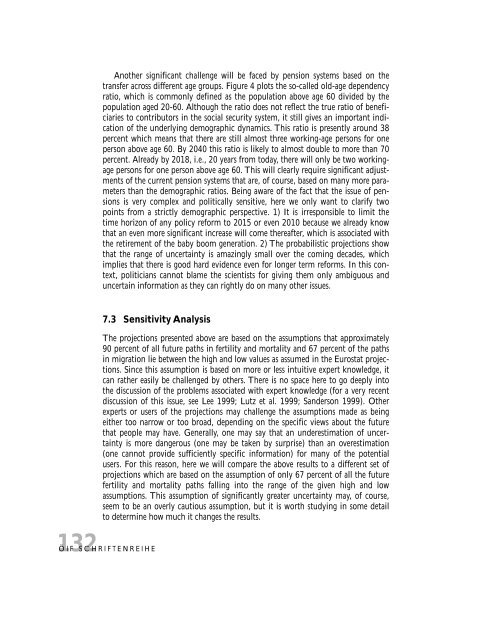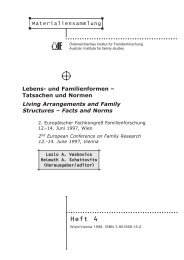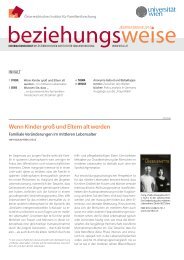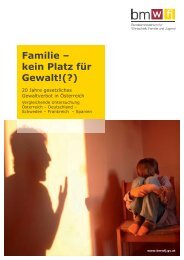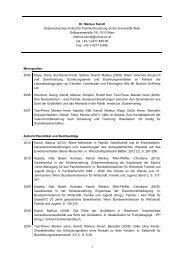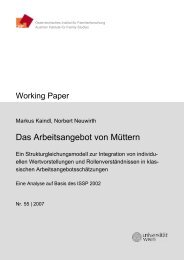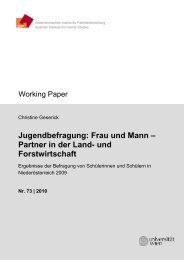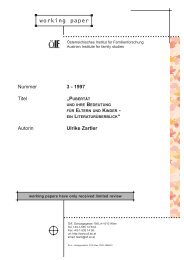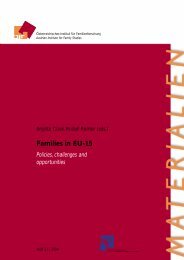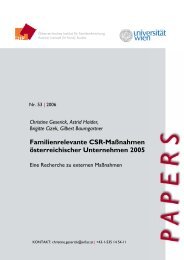Kompendium der Familienforschung in Ãsterreich, Schriftenreihe Nr. 7
Kompendium der Familienforschung in Ãsterreich, Schriftenreihe Nr. 7
Kompendium der Familienforschung in Ãsterreich, Schriftenreihe Nr. 7
Erfolgreiche ePaper selbst erstellen
Machen Sie aus Ihren PDF Publikationen ein blätterbares Flipbook mit unserer einzigartigen Google optimierten e-Paper Software.
Another significant challenge will be faced by pension systems based on the<br />
transfer across different age groups. Figure 4 plots the so-called old-age dependency<br />
ratio, which is commonly def<strong>in</strong>ed as the population above age 60 divided by the<br />
population aged 20-60. Although the ratio does not reflect the true ratio of beneficiaries<br />
to contributors <strong>in</strong> the social security system, it still gives an important <strong>in</strong>dication<br />
of the un<strong>der</strong>ly<strong>in</strong>g demographic dynamics. This ratio is presently around 38<br />
percent which means that there are still almost three work<strong>in</strong>g-age persons for one<br />
person above age 60. By 2040 this ratio is likely to almost double to more than 70<br />
percent. Already by 2018, i.e., 20 years from today, there will only be two work<strong>in</strong>gage<br />
persons for one person above age 60. This will clearly require significant adjustments<br />
of the current pension systems that are, of course, based on many more parameters<br />
than the demographic ratios. Be<strong>in</strong>g aware of the fact that the issue of pensions<br />
is very complex and politically sensitive, here we only want to clarify two<br />
po<strong>in</strong>ts from a strictly demographic perspective. 1) It is irresponsible to limit the<br />
time horizon of any policy reform to 2015 or even 2010 because we already know<br />
that an even more significant <strong>in</strong>crease will come thereafter, which is associated with<br />
the retirement of the baby boom generation. 2) The probabilistic projections show<br />
that the range of uncerta<strong>in</strong>ty is amaz<strong>in</strong>gly small over the com<strong>in</strong>g decades, which<br />
implies that there is good hard evidence even for longer term reforms. In this context,<br />
politicians cannot blame the scientists for giv<strong>in</strong>g them only ambiguous and<br />
uncerta<strong>in</strong> <strong>in</strong>formation as they can rightly do on many other issues.<br />
132<br />
7.3 Sensitivity Analysis<br />
The projections presented above are based on the assumptions that approximately<br />
90 percent of all future paths <strong>in</strong> fertility and mortality and 67 percent of the paths<br />
<strong>in</strong> migration lie between the high and low values as assumed <strong>in</strong> the Eurostat projections.<br />
S<strong>in</strong>ce this assumption is based on more or less <strong>in</strong>tuitive expert knowledge, it<br />
can rather easily be challenged by others. There is no space here to go deeply <strong>in</strong>to<br />
the discussion of the problems associated with expert knowledge (for a very recent<br />
discussion of this issue, see Lee 1999; Lutz et al. 1999; San<strong>der</strong>son 1999). Other<br />
experts or users of the projections may challenge the assumptions made as be<strong>in</strong>g<br />
either too narrow or too broad, depend<strong>in</strong>g on the specific views about the future<br />
that people may have. Generally, one may say that an un<strong>der</strong>estimation of uncerta<strong>in</strong>ty<br />
is more dangerous (one may be taken by surprise) than an overestimation<br />
(one cannot provide sufficiently specific <strong>in</strong>formation) for many of the potential<br />
users. For this reason, here we will compare the above results to a different set of<br />
projections which are based on the assumption of only 67 percent of all the future<br />
fertility and mortality paths fall<strong>in</strong>g <strong>in</strong>to the range of the given high and low<br />
assumptions. This assumption of significantly greater uncerta<strong>in</strong>ty may, of course,<br />
seem to be an overly cautious assumption, but it is worth study<strong>in</strong>g <strong>in</strong> some detail<br />
to determ<strong>in</strong>e how much it changes the results.<br />
ÖIF SCHRIFTENREIHE


